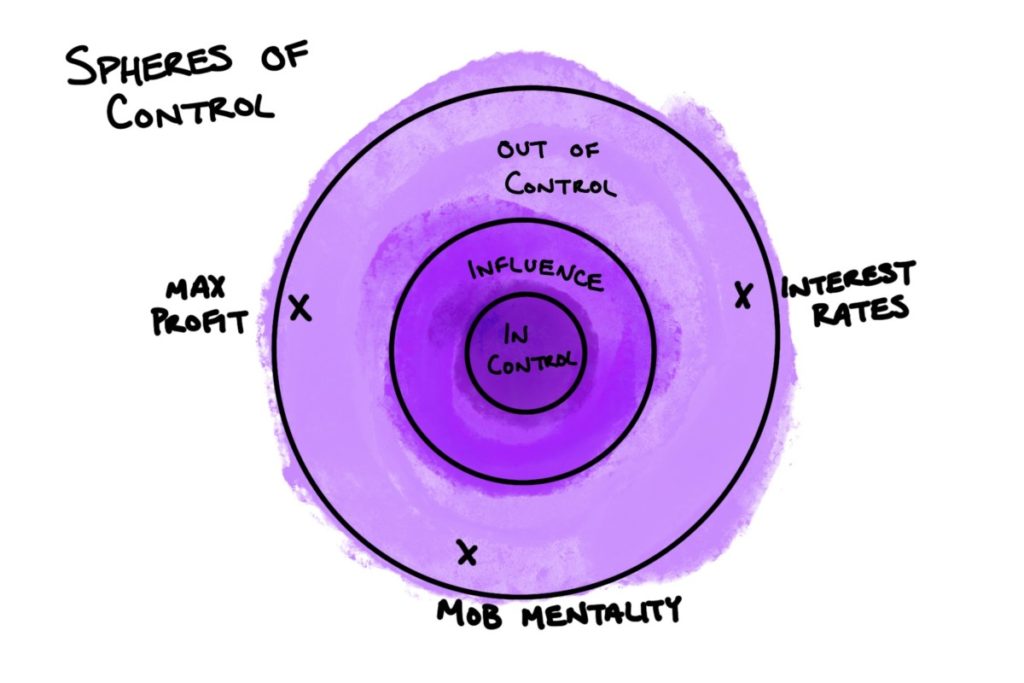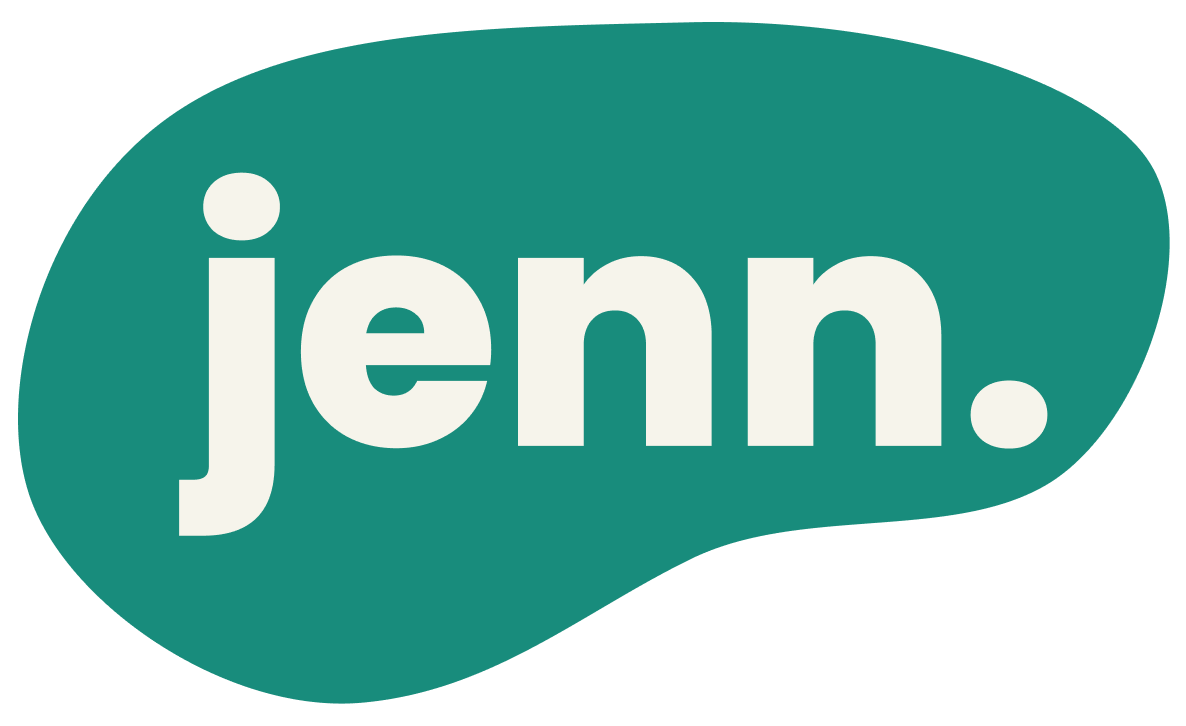Maybe it’s a reckoning, maybe it’s gaslighting
As tech layoffs continue to purge tons of talented people across the board, it’s hard not to worry that maybe product design and research departments are getting hit harder than others.
Because we are a pretty empathic and introspective crowd, I see a lot of reflection and consideration about our professional value. I see a lot of questions too, like… “Why is this happening?” “Is the reckoning here?” “Do we deserve it?”
Before we weaponize our introspective superpowers on ourselves, I want to take a second to talk about spheres of influence and control. You might have seen a bullseye diagram with a small circle labeled “What you can control.” The next circle is larger and is labeled “What you can influence.” And the largest circle is labeled “Outside of your control.”

There’s a lot you can do within your sphere of control to expand it, what you do in this space can also change the size of your influence sphere – but note – that influence sphere is still firmly outside of what you can control.
Ok, keep all of this in mind, we’ll come back to it and make it more concrete later.
Let’s revisit that why question. Why are so many designers and researchers being let go in these layoffs? I think it comes down to 3 interconnected things.
1. Increasing interest rates means money isn’t free anymore.
With interest rates so low, it made it essentially free to borrow money. There wasn’t a ton of risk, and investors would spread the money around and make bets on who would be the next unicorn and make tons of money.
For a long time going out and raising investment rounds relied on pontification, pictures, and promises. You had to tell a great story and show some very sexy mockups to get an investor emotionally attached to your idea and place their bet on you. It didn’t have to be real or even viable at this point. Actually it’s part of the strategy, it could only be real if big money bags were handed over so you could brute force it to life. With those money bags, you next had to show growth, which is easy to do with huge hiring goals, acquisitions, and massive marketing efforts.
Valuations started exploding. Unicorns went from being rare, to being less and less so. There was so much money and excess. It started reaching a fever pitch in the wild hiring boom of 2021.
Not only was hiring booming- so were salaries and demands of employees. I suspect employer resentment was also on the rise.
2. Shifting priorities to maximizing revenue and profit over growth.
Inflation expanded like a giant hot air balloon and it got so silly that the Fed decided to finally step in and start putting checks in place to cool it down. One way to reduce that surplus of money- increase interest rates.
This means that the 3P’s of raising money for companies wasn’t going to work anymore. There’s a new P in town- Proof. Growth is not impressive anymore and won’t cut it- now we need to see returns on these investments. That means more revenue, more profits.
With employees being one of, if not the biggest expense for a company, it took .5 seconds for companies to start looking at reducing that expense.
This is a very short sighted point of view. Earnings calls happen quarterly, so that means optimizing for a few months ahead. So anyone who doesn’t literally produce dollars for the company directly and immediately are more in danger of the chopping block. Design and research fall into this “non-crucial” space, while not usually being completely eliminated, the department sizes are greatly reduced.
3. Mob mentality.
Some companies over-hired during the pandemic and layoffs in recent months were a course correction for them. Layoffs are a hammer of a solution, quick, violent, effective. Unfortunately, in our instant gratification driven economy, everything started looking like a nail.
We saw extreme examples like Twitter who reduced the workforce to a skeleton crew – and the smirks we gave at the stupidity faded as months later Twitter still functions. A victory for the employer who now feels that they were correct that there were too many and too entitled employees. A sobering scene for employees who now wonder if they really aren’t necessary.
Another example is Shopify. They announced laying off 20% of the company and saw a 23% bump in the stock market the next day. A literal squeal of glee from investors.
Layoffs are now a lever that every company is being asked to use by their investors and boards. If you’re not doing it, are you really being fiscally responsible? Everyone else is, why aren’t you? It becomes an even stronger case when we aren’t seeing negative consequences to these cuts. (If you ignore the human part of it, of course.)
I can’t stress the short term-ness of this enough. It’s like a crash diet. For sure you can live on 400 calories a day and you’ll see your weight drop quickly. Unfortunately your success is going to be short lived and you are likely causing a lot of internal damage that will take enormous amounts of effort down the road to repair. In extreme cases it might even be fatal.
Back to the bullseye
The fact is a lot of us are unemployed and this is a very concerning thing. I totally get why folks are questioning our value. If we match the short term lens of the C-suite: “Designers and researchers laid off == design and research not valuable” checks out. But when we layer on assumptions, and sometimes are even told, that it’s our fault we’re not seen as valuable, I wholeheartedly disagree. I get why it’s tempting to entertain those thoughts- it’s so scary to be affected by things you don’t and can’t control.
I am all for introspection. I think there are so many good conversations happening and to be had around how can design and research become more crucial and valuable to businesses. How can we be more effective communicators? How can we better serve users AND the bottom line? Assessing our own skills and addressing gaps is a great thing that we should all be doing regularly.
But that is about it in terms of what is in our control. Even what we can influence is severely limited by whether or not a company is OPEN to being influenced. It’s not uncommon for them to be actively incentivized to not be.
Interest rates, hyper focus on the bottom line, and mob mentality are fully outside of our control as designers and researchers. In fact, they don’t have anything to do with design and research disciplines at all.
So, let’s absolutely continue to grow and mature our disciplines and as individuals. But let’s not let folks playing number games shake off responsibility for their actions and internalize that entire disciplines are not valuable or worthy. Don’t be gaslit, and don’t gaslight yourself.
Let’s do what we do best, take the broader view and play the longer game.

